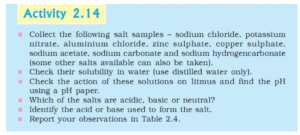Table of Contents
Activity 2.14 NCERT Class 10 Science, Chapter 2 Acids, Bases, and Salts
Procedure:

Answer:
Solubility:
All salts of inorganic acids and inorganic bases like HCl, NaOH, etc are readily soluble in water.
Salts of organic acids and organic bases are mostly soluble in water but some may be insoluble. Here only one organic salt Sodium acetate is asked which is highly soluble in water.
Explanation of solubility:
Salts of inorganic acids are polar in nature. Polar substances dissolve in polar solvents like water. Salt of organic acids and bases are mainly non-polar in nature. They dissolve in a non-polar solution like Benzene, and carbon tetrachloride.
The PH of the solution:
Salts of strong acids and strong bases form a neutral solution with water. E.g. Sodium chloride.
Salts of a strong base and weak acid form a basic solution. e.g. Sodium acetate solution. Sodium acetate is a salt of strong base sodium hydroxide and a weak acid Acetic acid. It will turn the PH paper into red or yellow.
Salts of a weak base and strong acid form acidic solution with water. E.g. Ammonium chloride. Ammonium hydroxide is a weak base as compared to hydrochloric acid. So its salts form an acidic solution with water.
Explanation:
The PH of the solution depends on the presence of Hydrogen ion (H+) and hydroxide ion (OH–). In pure water, they remain at equilibrium with 10-7 each.
When we add salt of a strong acid and strong base it dissociates into its ion fully and equilibrium remains the same.
NaCl ————-> Na+ + Cl–
But a salt of a strong acid and a weak base ( e.g. Ammonium chloride) or salt of a weak acid and strong base (e.g. Sodium acetate) does not dissociate fully and disturb the equilibrium of water. In the former case solution have more H+ while the latter has more OH–.
Conclusion:
This experiment shows that all salts whether organic or inorganic are readily soluble in water.
PH of salts is near neutral (around 7). Small changes in the PH of salts depends on its precursor. Salts of strong acid and weak base are acidic. Similarly, Salts of a weak acid and strong base are basic.
Table
| Salt | PH used | Acid used | Base used |
| Sodium chloride(NaCl) | 7 | Hydrochloric acid(HCl) | Sodium hydroxide(NaOH) |
| potassium nitrate(HNO3) |
7 | Nitric acid(HNO3) | Potassium hydroxide(KOH) |
| Aluminium chloride(AlCl3) | 7 | Hydrochloric acid(HCl) | Aluminium hydroxide(Al(OH)3) |
| zinc sulphate | 7 | Sulphuric acid(H2SO4) | Zinc hydroxide(Zn(OH)2) |
| Copper sulphate | Less than 7 | Sulphuric acid(H2SO4) | Copper hydroxide(Cu(OH)2) |
| Sodium acetate | More than 7 | Acetic acid (CH3COOH) | Sodium hydroxide(NaOH) |
| Sodium carbonate | More than 7 | Carbonic acid (H2CO3) | Sodium hydroxide(NaOH) |
| Sodium hydrogen carbonate | More than 7 | Carbonic acid (H2CO3) | Sodium hydroxide(NaOH) |
Next: Experiment to demonstrate a solid crystal are really dry or not, Activity 2.15.
See also: How to make a salt, Activity 2.13.
Ref: Chapter 2.
Activity 2.14 NCERT Class 10 Science
It is given in above activity
So you can fill self
Thanking you
Svm Deoria
What is the conclusion ,, table 2.4 is not filled !
Stupidity
Superr
But what is conclusion
what is the conclusion of above experiment
what is the conclusion of above experiment
what is the conclusion
Nice